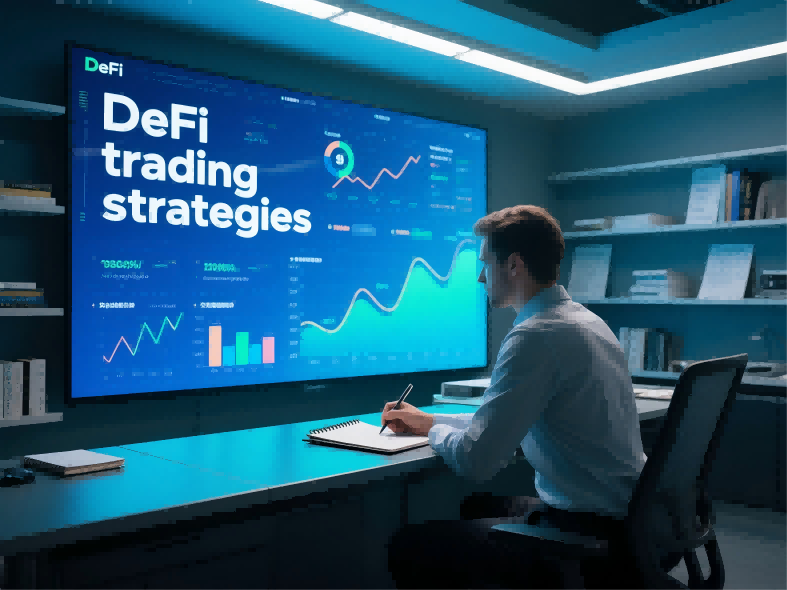Trade smarter. Not harder. Welcome to the world where finance meets freedom.
The rise of DeFi—short for decentralized finance—has rewritten the rules of trading. No middlemen, no gatekeepers, and no closing bells. Whether you're casually swapping tokens from your phone or actively managing yield-generating positions, DeFi opens up a whole new way to think about money and markets. But with new freedom comes new responsibility, and that’s where smart trading strategies come into play.
Let’s break down what DeFi trading really looks like—and how you can approach it with confidence.

Unlike traditional finance, DeFi gives users direct access to decentralized exchanges (DEXs), lending platforms, and synthetic assets—all powered by smart contracts. The good news? You’re in full control. The challenge? You need to know how to navigate it safely and strategically.
Whether you’re yield farming on Curve, executing leveraged trades on GMX, or providing liquidity on Uniswap, every move requires a plan. And with the DeFi space evolving fast, staying ahead means knowing which strategies work—and when.
Providing liquidity to DEXs is one of the core ways to earn in DeFi. When you deposit tokens into a pool, you earn a share of the trading fees. Platforms like Uniswap, Balancer, and SushiSwap reward LPs with protocol fees—and sometimes bonus tokens.
But it’s not just passive income. Impermanent loss is real, especially during volatile markets. To manage it, some traders use “concentrated liquidity” (like on Uniswap v3) to fine-tune their exposure zones, or they choose pairs with lower volatility like stablecoin pairs (e.g., USDC/DAI).
Pro tip: LP strategies work best when you understand how pool composition, volume, and market trends interact.
If you’ve ever traded on dYdX, GMX, or Level Finance, you know DeFi’s answer to margin trading is no joke. Decentralized perpetual contracts allow you to go long or short with leverage—without an account, broker, or even KYC.
Used wisely, this can amplify returns. Used recklessly, it’s a recipe for liquidation. Many DeFi traders use isolated leverage and stop-loss automation to manage downside risk. Others hedge spot positions with short perp contracts to protect against market swings.
Trading motto: Leverage is a tool, not a shortcut.
Arbitrage in DeFi is alive and well. With so many platforms and chains, price inefficiencies appear more often than you’d think. Traders monitor DEXs for price gaps—say ETH trades at $1,900 on Uniswap but $1,920 on Curve—and exploit the difference.
Some use bots, others do it manually. Cross-chain bridges, like Stargate or Synapse, also create arbitrage paths when assets trade at different rates across ecosystems.
Reality check: Gas fees and slippage can eat your edge. Successful DeFi arbitrage is about precision, timing, and keeping costs low.
Protocols often reward users with native tokens for participating—staking, borrowing, or supplying liquidity. Yield farmers chase the highest returns by moving capital across platforms like Aave, Curve, Convex, and Lido.
But don’t just follow the highest APY. Smart yield farming means evaluating token inflation, lock-up terms, and potential dumping pressure.
Better strategy: Pair auto-compounding tools like Beefy or Yearn with stablecoin strategies to balance risk and reward.
Some of the best DeFi strategies aren’t about constant trading—they’re about strategic holding. Staking tokens like ETH, SOL, or ATOM earns yield while supporting network security. Liquid staking solutions like Lido and Rocket Pool let you stay liquid while earning rewards.
In volatile markets, many traders allocate part of their portfolio to “set-and-forget” staking strategies while actively trading a smaller portion. It’s diversification—Web3 style.
DeFi isn’t just a trend—it’s a shift in how we interact with money. The most successful traders aren’t just chasing yield or leverage; they’re building systems that fit their risk profile, market knowledge, and financial goals.
As always, do your own research (DYOR). Smart contract risk, protocol hacks, rug pulls—they’re all part of the landscape. But with the right tools, insights, and community, DeFi trading can be not only profitable—but empowering.
"DeFi: Trade freely. Think differently. Own your edge."
If you’re ready to explore strategies that put you in the driver’s seat—no banks, no borders, no limits—DeFi is where the future of trading is already happening.
Need a platform to get started with real-time tools, low fees, and full control? You know where to find us.
Spot trading is straightforward: you buy an asset like Bitcoin, Tesla stock, or gold, and you profit if the price goes up
Read MoreTrading has always carried an air of possibility. The idea of turning a well-timed decision into a life-changing profit a
Read MoreStart your CFD trading
Your All in One Trading APP PFD